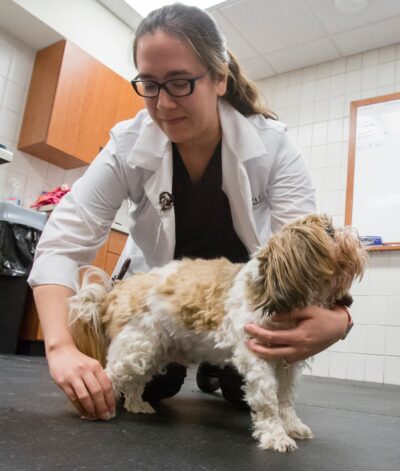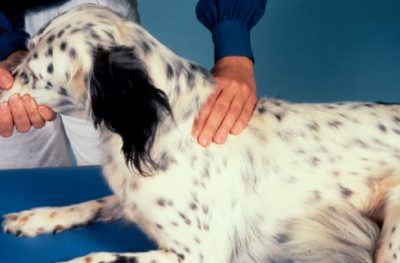Postural reflexes are complex reponses that maintain an animal’s normal upright postion. Abnormal postural reflexes may indicate neurologic disease. Proprioception loss is one of the earliest abnormal postural reflexes indicating neurologic disease.
The purpose of a systematic neurologic examination is to establish the presence of neurological disease and to localize the lesion.
First, visualize the animal overall visualization – does the dog exhibit ataxia, paresis, or paralysis, and are the forelimb and/or rear limbs involved. Then evaluate postural reflexes, followed by spinal reflexes and finally, pain perception.

You should observe the mental status, the posture of the animal, its gait, including forward, backward and in tight circles. Palpation of the spine is important.

Proprioception loss is the earliest indicator of spinal disease and should be performed in every physical and orthopedic examination. Proprioceptive positioning is performed by flexing the paw so the dorsal surface is on the floor. The animal should immediately return the paw to a normal position.
Proprioception loss as exhibited by delayed or absent correction of the knuckled paw indicates neurologic disease. Worn dorsal toenails, skin abrasions, or calluses on the dorsum of the foot may signify long-standing proprioceptive deficits.
Wheelbarrowing is performed by having the animal bear weight on the thoracic limbs while it is being supported under the abdomen.
Normal animals walk forward with coordinated movements of both thoracic limbs.
Slow initiation of movement during wheelbarrowing may be due to a cervical spinal cord, brainstem, or cerebral lesion. Exaggerated movements (dysmetria) may indicate cervical spinal cord, lower brainstem, or cerebellar abnormalities.
Hopping is tested with the animal positioned as for wheelbarrowing, except one thoracic or pelvic limb is lifted from the ground. The entire weight of the animal is supported on one limb as the patient is moved medially and laterally.
Video shows forelimb hopping.
Poor initiation of hopping suggests proprioceptive deficits. Poor movement suggests motor deficits. Asymmetry may help to lateralize a lesion. Generally, testing thoracic limbs yields more reliable information than testing pelvic limbs.
Video shows rearlimb hopping.
Extensor Postural Thrust is performed by supporting the animal under the thorax while lowering it to the floor. When the pelvic limbs touch the floor, they should move caudally in symmetric walking movements to achieve a position of support. The patient assessment is the same as for wheelbarrowing.
Hemistanding and hemiwalking are performed by elevating the front and rear limbs of one side so that all of the animal’s weight is supported by the opposite limbs. Lateral walking movements are then evaluated. The patient assessment is the same as for wheelbarrowing.
Visual placing is tested by allowing the animal to see the table surface. Normal animals reach for the surface before the carpus touches the table. Visual placing requires normal visual pathways to the cerebral cortex, communication from the visual cortex to the motor cortex, and motor pathways to the forelimb peripheral nerves. A lesion of any portion of the pathway may cause a deficit in the placing reaction.
Tactile placing is performed by supporting the animal under the thorax and obscuring its vision. The distal thoracic limbs (at or below the carpi) are brought in contact with the edge of a table. The normal response is immediate placement of the feet on the table surface in a position that will support weight. Normal tactile placing with absent visual placing indicates a lesion in the visual system.
Normal visual placing with abnormal tactile placing suggests a sensory pathway lesion. Cerebral and diencephalic lesions produce a deficit in the contralateral limb. Lesions below the midbrain usually produce an ipsilateral deficit.
